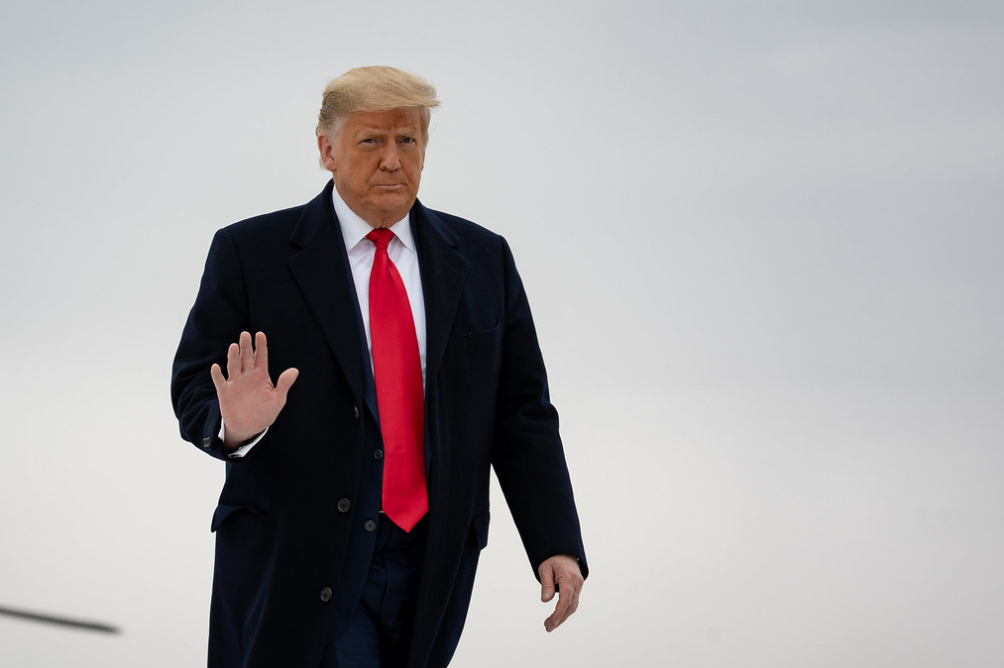Trump Income Tax and Tariff Proposals: Details & Analysis
Last week, former President Trump took his affinity for tariffs much further, floating the possibility of entirely replacing the federal income tax with new tariffs. He also raised other ideas like eliminating taxes on tipped income and lowering the corporate taxA tax is a mandatory payment or charge collected by local, state, and national governments from individuals or businesses to cover the costs of general government services, goods, and activities.
rate by one percentage point. Rather than constituting a fiscally responsible and coherent tax reform plan to boost growth and competitiveness, the latest ideas lack seriousness and merit. If pursued, they would fall well short of fundamental tax reform while hurting American workers and businesses. Here are five things to know about Trump’s tax and tariffTariffs are taxes imposed by one country on goods or services imported from another country. Tariffs are trade barriers that raise prices and reduce available quantities of goods and services for U.S. businesses and consumers.
ideas.
1. The Math Doesn’t Work
The individual income taxAn individual income tax (or personal income tax) is levied on the wages, salaries, investments, or other forms of income an individual or household earns. The U.S. imposes a progressive income tax where rates increase with income. The Federal Income Tax was established in 1913 with the ratification of the 16th Amendment. Though barely 100 years old, individual income taxes are the largest source of tax revenue in the U.S.
raises more than 27 times as much revenue as tariffs currently do, but it’s not the gap in revenue levels that makes replacement impossible. The bigger issue is the relative size of the tax baseThe tax base is the total amount of income, property, assets, consumption, transactions, or other economic activity subject to taxation by a tax authority. A narrow tax base is non-neutral and inefficient. A broad tax base reduces tax administration costs and allows more revenue to be raised at lower rates.
. The most recent Internal Revenue Service data for tax year 2021 shows American taxpayers reporting almost $15 trillion of individual income while paying $2.2 trillion of taxes, for an average tax rateThe average tax rate is the total tax paid divided by taxable income. While marginal tax rates show the amount of tax paid on the next dollar earned, average tax rates show the overall share of income paid in taxes.
of 14.9 percent. Total imports in 2021 were $3.4 trillion, but that includes services that are not subject to tariffs. Looking at goods alone, imports totaled $2.8 trillion in 2021, while tariff revenues were $80 billion, for an average tax rate of 2.9 percent.
To replace the roughly $2 trillion of revenue raised by the individual income tax with tariffs would require astronomically high tariff rates.
For instance, an across-the-board tariff hike of 69.9 percent on the level of goods imports from 2023 ($3.1 trillion) seems like it could fully replace individual income tax revenues. But that calculation is a significant understatement. It fails to account for several factors that would reduce how much revenue the tariff would raise, including noncompliance and the behavioral response of people reducing how much they import.
- Assuming 15 percent noncompliance, revenue from a 69.9 percent tariff falls to $1.8 trillion
- Assuming an elasticity of -0.997 percent, revenue drops to about $560 billion (imports drop by slightly less than 1 percent for a 1 percent price increase)
Replacing the individual income tax with tariffs is thus completely unrealistic—and the above illustration doesn’t even account for additional factors that would further reduce the revenue raised, like holding the price level constant (which requires the calculation to use the inclusive tax rate), tax offsets, and the negative economic effect of higher tariffs.
2. Tariffs Were a Main Source of Revenue for a Drastically Smaller Government
Former President Trump has pointed to the tariff in American history as a motivation for his idea, but the federal government of a century ago is much different from the federal government of today—as is the American economy. Economists Chad Bown and Douglas Irwin have previously explained that tariffs have not been a main source of federal revenue since 1914, and it would be impossible to rely on tariffs for current spending levels.
Back when tariffs were a main source of government revenue, federal government spending was a very small fraction of GDP, barely exceeding 2 percent of GDP in total. As Bown and Irwin show, government spending now is drastically larger. In 2023, the federal government spent 22.7 percent of GDP—about 10 times as much government spending as a share of the economy than when tariffs were a primary revenue source.
Across four major categories alone, 2023 spending accounted for more than 14 percent of GDP (5 percent on Social Security, 3.7 percent on Medicare, 3.3 percent on defense, and 2.4 percent on net interest on the federal debt). Meanwhile, imports comprised about 11.4 percent of GDP—taxing imports at 100 percent would not raise sufficient revenue to pay for major programs alone and would significantly shrink the intended tax base.
3. Higher Tariffs Would Raise Costs for Americans
Tariffs clearly cannot replace the revenue raised by the income tax, but some may still think that higher tariffs should be pursued even if the purpose is not full revenue replacement. Often, the idea that we need higher tariffs is based on misunderstandings about how tariffs work and their impact on jobs and production. Trump’s calls for a 10 percent universal tariff, a 60 percent tariff on China, and a 200 percent tariff on electric vehicles fall prey to these misunderstandings.
When the U.S. imposes a tariff, the person or business that imports the good is responsible for paying the tariff—not a foreign country or a foreign business. Depending on different factors, different people in the economy could bear the ultimate economic burden of a tariff. For example, suppose the U.S. places a tariff on dinnerware. If a U.S. retailer imports dinnerware, it must physically make the payment for the 25 percent import tariff on the plates it purchases. But the burden could fall elsewhere. If the foreign seller lowers its own prices to offset some of the tariff cost, it bears part of the burden. If the U.S. retailer raises its own prices, the people who buy plates and bowls from the store bear the tariff burden.
Recent studies on U.S. tariffs have found near 100 percent pass-through of the 2018-2019 trade war tariffs to U.S. importers. That means foreigners have not, directly or indirectly, paid U.S. tariffs—instead, the billions in import taxes raised by the U.S. government have been paid by U.S. businesses and consumers. The economic evidence leaves no dispute that even higher tariffs would further increase costs for American consumers and businesses.
4. Higher Tariffs Would Harm American Workers and Businesses
Even though tariffs cause higher prices for businesses and retail consumers, policymakers might argue that tariffs are worth it because they benefit some sectors of the economy enough to outweigh the harm of higher prices. That sentiment is mistaken. Tariffs have a net negative impact on the economy, which can happen through different channels:
- One possibility is a tariff may be passed on to producers and consumers in the form of higher prices. Whether the cost of parts and materials rises (reducing private sector output) or final consumer prices rise (reducing the after-tax value of both labor and capital income), the ultimate effect is to reduce the return to labor and capital, incentivizing Americans to work and invest less, leading to lower output on net.
- Alternatively, the U.S. dollar may appreciate in response to tariffs, offsetting the potential price increase for U.S. consumers. The more valuable dollar, however, would make it more difficult for exporters to sell their goods on the global market, resulting in lower revenues for exporters. This would also result in lower U.S. output and incomes for both workers and owners of capital, reducing incentives for work and investment and leading to a smaller economy.
Academic and governmental studies have confirmed the overall damage tariffs cause to the American economy. For example, Federal Reserve economists Aaron Flaaen and Justin Pierce estimated the effects of the 2018-2019 tariffs on the U.S. manufacturing sector accounting for both the benefits of tariffs to protected companies and the costs of tariffs to companies that faced higher input prices or other distortions. On net, they found a decrease in manufacturing employment due to the tariffs: the positive contribution from protected industries was significantly outweighed by the effects of rising input costs and by retaliatory tariffs.
Trump’s proposed tariff hikes would bring higher costs that disadvantage American companies competing abroad and reduce the after-tax incomeAfter-tax income is the net amount of income available to invest, save, or consume after federal, state, and withholding taxes have been applied—your disposable income. Companies and, to a lesser extent, individuals, make economic decisions in light of how they can best maximize their earnings.
of households, invite foreign retaliation that further erodes the competitiveness of U.S. producers, and distort work and investment decisions to the detriment of the entire economy. In effect, tariffs would redistribute income from American consumers and downstream industries toward protected industries, making us all worse off.
5. Tariffs and Income Tax Exclusions Are Not Tax Reforms
Tax policy changes should aim to boost growth and competitiveness. Fundamental reform efforts to transform the U.S. income tax system to a flatter consumption taxA consumption tax is typically levied on the purchase of goods or services and is paid directly or indirectly by the consumer in the form of retail sales taxes, excise taxes, tariffs, value-added taxes (VAT), or an income tax where all savings is tax-deductible.
system in that vein should be applauded. Unfortunately, Trump’s tariff and tax proposals are a far cry from that.
On the tax front, Trump’s recent ideas include excluding tip income from taxation entirely and lowering the corporate income taxA corporate income tax (CIT) is levied by federal and state governments on business profits. Many companies are not subject to the CIT because they are taxed as pass-through businesses, with income reportable under the individual income tax.
rate by one percentage point.
Reducing the burden of the individual income tax can be part of a fundamental tax reform, but exempting a specific category of income is not a principled approach. Doing so would invite significant gaming to take advantage of the exemption and create distortions across households with similar levels but different types of earnings. IRS data from 2018 shows about 6.1 million taxpayers had reportable tip income with an average amount of $6,249 per taxpayer ($38.3 billion in total). While tipped income represents a relatively small slice of total income, it would reduce revenue by billions annually while worsening the structure of the tax code. Carveouts for certain sectors or types of workers is not a principled way to reduce tax burdens.
Contrastingly, a lower corporate income tax rate is a principled way to improve investment incentives and boost international competitiveness. However, reducing the rate by one percentage point would not outweigh the significant damage caused by tariff hikes and the resulting retaliation from foreign governments. The goal of revenue-neutral tax reform is not to replace one distortionary tax with another, but to reduce the overall distortionary effect of the tax system on both the tax cut and the tax offset sides.
Policymakers drawn to Trump’s tariff and tax ideas should go back to the drawing board. Otherwise, they might squelch the opportunity for fundamental tax reform by pursuing unprincipled, economically harmful, and nonsensical ideas.
Stay informed on the tax policies impacting you.
Subscribe to get insights from our trusted experts delivered straight to your inbox.
Subscribe
Share






